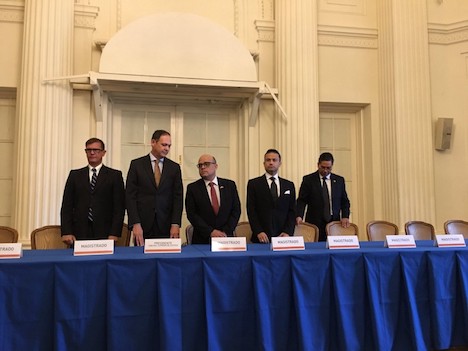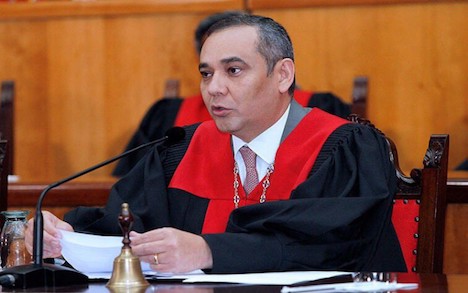|

|
Ambassadors reject unprecedented installation of parallel Supreme Court for Venezuela by the OAS
 Print This Print This
By Staff Writers | Red58
teleSUR
Saturday, Oct 14, 2017
An affront to Venezuela. Parallel governments are a US tool to intervene and loot other countries' resources.
The so called Supreme Court named by the Venezuelan legislature, acting illegally via its opposition majority, was "installed" today in the seat of the Organization of American States in Washington and began its "judicial year", an unprecedented action rejected by the majority of OAS ambassadors, according to press reports.
 |
| Installation of the so-called Venezuelan Supreme Court in exile
in the OAS Americas' Room in Washington |
This unprecedented event has caused great discontent among many of the ambassadors to the OAS, both from countries supportive of Venezuela and from countries critical of its government, led by Nicolás Maduro, as various of the ambassadors explained to the news agency EFE.
The event, held in the Americas Room, began with the presence of Luis Almagro, the OAS Secretary General, who thus validated yet another new insult to Venezuela's democracy. Among those present, mostly Venezuelans, were numerous fugitives protected from Venezuelan justice by the US State Department.
Among these were the ex-mayors David Smolansky (of El Hatillo) and Ramón Muchacho (of Chacao), who fled Venezuela to escape arrest on charges of complicity in the wave of violence between April and July earlier this year, during opposition calls for the ousting of President Nicolás Maduro. Smolansky has called for US military intervention in Venezuela.
Almagro asserted that the opposition's parallel OAS Court opens the way towards institutionality in Venezuela but failed to specify where and how this would be done, for example whether it would hold sessions in the OAS as some of those involved have stated to the media over the last few days. Almagro only said that "on starting its work it clears the way to institutionality in Venezuela" while the Venezuelan opposition said it would hold its sessions in the OAS, in Colombia and in a private office in Washington. After the activity in the OAS Americas Room, the parallel court held a working session in the Miranda Room in the OAS and next week will meet somewhere in Colombia yet to be decided.
Venezuela's former Attorney General, Luisa Ortega Diaz, now based in Colombia's capital Bogota, had been slated as one of the event's star turns but did not receive a US visa, presumably for her past association with Chavismo and for the corruption accusations she faces. A US consular official in Bogota said that one obstacle was that all her bank accounts in Venezuela are frozen and thus "there was a danger at present that she might remain illegally in the United States".
The OAS, with its Secretary General Luis Almagro, has already held other Venezuelan opposition activities in its main auditorium, the Americas Room, on alleged human rights violation in Venezuela, which it hopes to use in an indictment before the International Criminal Court.
Those activities, also unprecedented, were likewise rejected by a great many ambassadors to the OAS, who have not attended any of them. But the diplomatic sources consulted by EFE consider "even more serious" the installation by the OAS of a judicial court, supposedly of a member country, but rejected by that country's government.
The Friday 13th event began in the morning at 9.00am with a floral offering to the Liberator Simon Bolivar and its proceedings started an hour later. It took place at a time of serious division within the OAS about the organization's role in Venezuela's political and social crisis and also reflects the contradictions and serious divisions within the Venezuelan opposition. While one group negotiates with the government and participates in elections, others continue calling for a coup d'etat, a parallel government and violence.
The use of "parallel government" operations around the world shows that it is now a decades-old US recipe applied mainly against countries with large reserves of natural resources. In the Congo in the 1960s, a United Nations supported parallel government lead to the murder of Patrice Lumumba and later to the ruthless dictatorship of Mobutu Sese Seko.
In February 2011, a group of high level Libyan officials supported by the United States rebelled against the Libyan government, joining the insurrection and creating a parallel government called the National Transition Council. The outcome is all too familiar, a NATO military intervention, the murder of Muammar al Gaddhafi and the country's collapse into chaos.
In south Yemen, the US and monarchies in the Arabian Gulf installed a parallel government after the Shi'ite Houtis took power on Saudi Arabia's doorstep right next to the strategic Bab al-Mandeb Strait, a key strategic oil transit channel.
Venezuela's Supreme Court of Justice called the installation of a parallel court by the Organization of American States this Friday in Washington a "judicial coup". "
 |
|
Maikel Moreno |
A communique by the Venezuelan Supreme Court, signed by its President Maikel Moreno, states “We firmly condemn this attempt at a Judicial Coup and we will remain stalwart in defense of our Sovereignty and our institutions".
Original Spanish language URL
Translated from Spanish by Tortilla con Sal
|
 Print This Print This

|
If you appreciated this article, please consider making a donation to Axis of Logic.
We do not use commercial advertising or corporate funding. We depend solely upon you,
the reader, to continue providing quality news and opinion on world affairs. Donate here
|
 |
Featured

|

